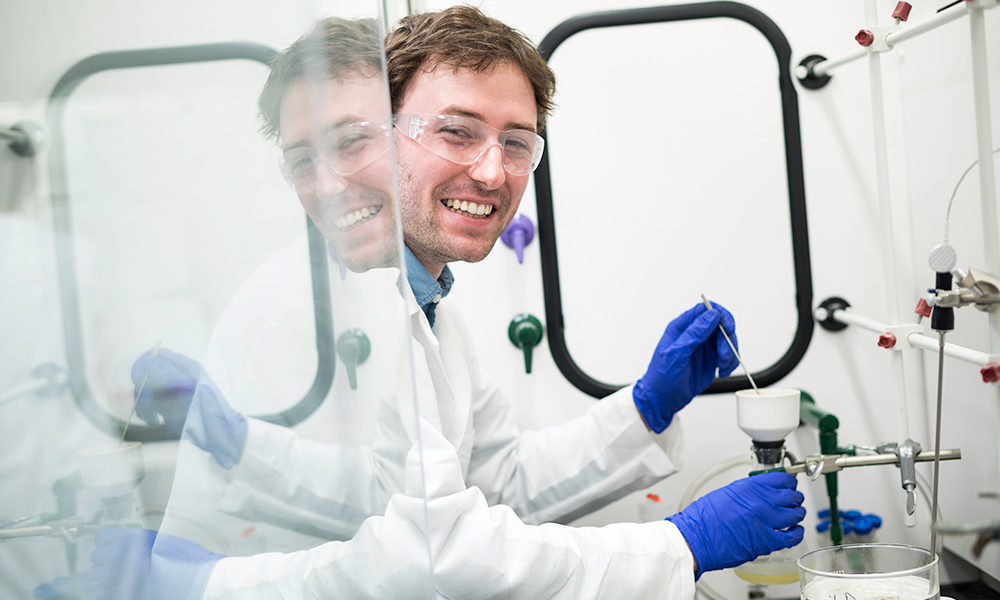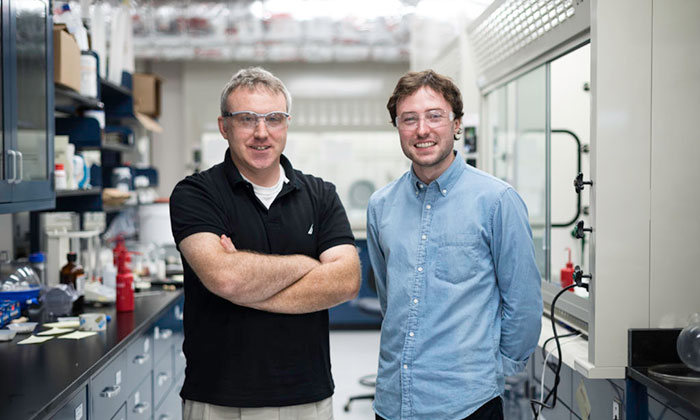Department News
Summer research that’s totally (nano)tubular
Chemistry major Austin Bailey ’18 (T5) has been able to carry out specialized research to a rare degree for an undergraduate student. As a participant in the National Science Foundation–funded Research Experience for Undergraduates (REU) in summer 2015, he was introduced to the world of carbon nanotubes. He’s been studying them ever since.
(T5) has been able to carry out specialized research to a rare degree for an undergraduate student. As a participant in the National Science Foundation–funded Research Experience for Undergraduates (REU) in summer 2015, he was introduced to the world of carbon nanotubes. He’s been studying them ever since.
Carbon nanotubes are extremely tiny sheets of carbon rolled into cylinders with diameters 10,000 times smaller than a human hair. Despite their small size, they are 10 times stronger than steel, yet are a fraction of the weight.
The unique chemical and physical properties of carbon nanotubes—including their strength, flexibility, and ability to conduct heat and electricity—fascinate researchers.
This summer, under a grant from the US Department of Energy, Bailey is working with Rochester chemistry professor Todd Krauss to develop a special polymer to attach other molecules to nanotubes. Their work could have significant applications for creating renewable energy sources.
“From the point of view of novel physics and chemistry, nanotubes are amazing because of their unique properties,” Krauss says. “They are the only material that can be made into a fiber and stretched to such an enormous height that in principle you could use them to tether a satellite to the earth. A steel cable wouldn’t work because it’s too heavy and would collapse under its own weight, but nanotubes are light enough, but strong enough, to do this.”
One of the challenges in working with carbon nanotubes is trying to attach other molecules to them—for instance, through chemical bonds—to take advantage of the nanotubes’ unique properties. When researchers try to chemically bond molecules to nanotubes, the bonds within the nanotubes break. This creates a defect in the tube itself and consequently diminishes the tube’s conducting properties.
The polymer Bailey is helping to develop will allow scientists to attached molecules to the tube without breaking nanotube chemical bonds. Krauss likens chemical bonds to Velcro: one side is the sticky side and one is the fuzzy side, and pulling them apart requires a lot of energy. The polymers would be more akin to Colorform stickers that cling to glass—they pull off easily and leave no glue or stickiness.
“This polymer that Austin is modifying will allow us to stick things on the nanotubes very gently compared to a direct chemical bond,” Krauss says.
The ultimate goal is to use the polymer to attach light-harvesting materials to the nanotubes. These materials would grab photons of light and then transfer the light’s energy to the nanotube. Another possibility is attaching materials to the nanotubes that take the protons in water and turn them into hydrogen, a clean-burning fuel. In both cases, the polymers would help create renewable energy solutions.
“I think physical chemistry is really cool,” Bailey says. “It’s so interesting how you can use physics to learn about what’s going on far below the microscopic level and then apply that to all these different ideas and problems in chemistry.”

Take Five student Austin Bailey (right) is pictured in the lab of chemistry professor Todd D. Krauss (left).
Bailey is working on synthesizing a polymer that will permit scientists to attach other molecules to nanotubes very easily. (J. Adam Fenster / University of Rochester)
